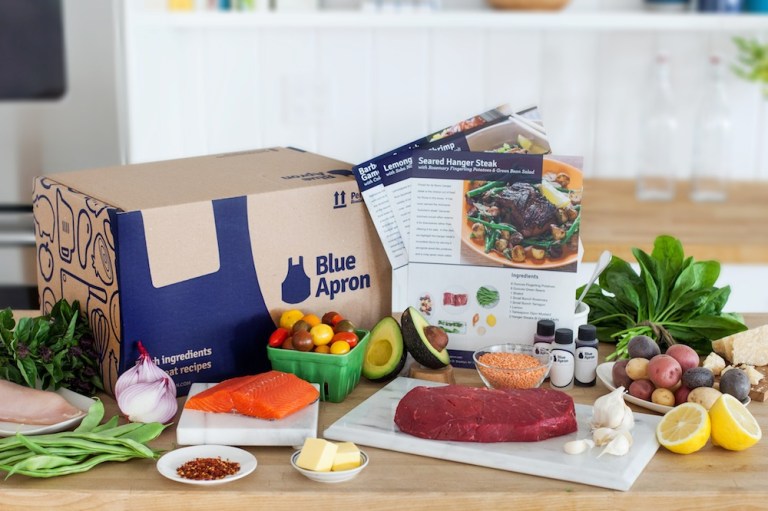
It’s not been easy to be Blue Apron in recent months. The meal kit company was one of the first to have the idea to send consumers pre-packaged meal kits to their front door. But the master has been surpassed by its students in many regards, as meal kits turned out to be a clever idea that was bit too easy to imitate. Berlin-based HelloFresh added 900,000 new customers in the U.S. last year, while Blue Apron reported 786,000 members as of the end of March. Now, there is some difference in how the two firms count their user bases: HelloFresh counts customers enrolled in its free trial program; Blue Apron does not. But even taking comparison out of play, as of March 2017, Blue Apron peaked at 1 million users and now seems to be slowing down.
The rough-looking numbers roll on from there. Blue Apron’s net revenue decreased 20 percent year over year as of their more recent quarterly earnings, reporting down to $196.7 million. Net losses clocked in at $31.7 million for the period that ended on March 31. On the upside, that is a decline: Net losses a year ago were around $52 million.
But Blue Apron remains committed to battling back — despite the crowded segment it finds itself in and despite the nearly endemic problem of churn that it faces. Meal kit customers Blue Apron’s have a notoriously short shelf life. They tend to sign on for the meal kit memberships, use them for a few months and then either switch to a new meal kit company or just go back to buying groceries as normal, with perhaps a few new ideas for dinner under their belts.
There are even apocryphal tales circulating through San Francisco of couples who change meal kits subscriptions every 30 days (the typical trial period) and have managed to eat a few free meals a week for a year as a result.
Blue Apron, however, said it’s starting to turn a corner, as its numbers are starting to build again, with an addition of 40,000 new users between Q4 2017 and Q1 2018. Average revenue per customer also ticked up $250 in the first quarter of 2018 compared to $248 in the fourth quarter and $236 in the first three months of 2017.
Front-end improvements have been paired with back-end restructuring; operational problems at a warehouse in New Jersey stalled — and in some cases even stopped — infrastructural growth. Those issues, according to Blue Apron, have been largely resolved, partially through the power of bringing in additional automation. The lowered net losses also indicated that the firm’s efforts of reducing packaging costs and cutting food waste were making advances. According to Brad Dickerson, Blue Apron’s CEO, the firm is on track toward profitability, or at least a break-even status, by 2019.
And now the meal kit company is trying something really different. Instead of delivering meal kits to customers’ front doors, Blue Apron is expanding to deliver goods to warehouse store aisles.
Blue Apron is selling meal kits at Costco — news that made a long-wary market take heed, as Blue Apron’s stock rose 9.5 percent.
How It Will Work
Blue Apron is not offering its whole service at Costco so much as it is offering customers a preview of the service. The company is instead offering its beef stir-fry and chicken tacos at 17 West Coast Costco locations.
The goal is to give customers a taste — literally — of what Blue Apron has to offer, according to its CEO. And the hope, of course, is that once their palates are wetted, Costco shoppers will be inspired to not only buy their meal kits from Costco, but also subscribe to Blue Apron to enjoy more of their offerings.
That preview comes at a discount: The Blue Apron meal kits for sale in Costco cost less than the meals sent to consumer’s doorsteps by the company. Blue Apron subscription boxes are $24.99 at the retailer this week, or about $6.25 a serving, whereas meals delivered add up to about $8.75 a serving.
Will It Work
Blue Apron believes Costco is a start, and that the goal is to create more partnerships with grocery players to put more of its meal kits in consumers’ hands.
Analysts think this is a sound strategy, since meal kits as online-only offers are turning out to be a tough line to be in, in terms of reach and maintaining profitability. Meal kit customers are, after all, a fickle group.
But a lot of those grocery players — feeling the pressure from the fleet of meal kits that Blue Apron helped launch — are entering the pre-packaged meal kit game themselves. Kroger, Albertsons, Amazon, Walmart Inc. and Peapod have all jumped into the meal kit game, hoping to capture and add to the 11 million U.S. households that bought a meal kit online or at a store in the last six months, according to Nielsen.
Grocery stores are also increasingly adding prepared meals to their line-ups to compete — often at a lower price point (already cooked) than their meal kit counterparts.
“I don’t see as much opportunity for Blue Apron or others to come into traditional food retail,” noted Jim Hertel, senior vice president of food consultancy Inmar Willard Bishop Analytics, according to The Wall Street Journal.
Blue Apron, as it fights to get back on top of a game it helped create, is very much hoping to prove him wrong.